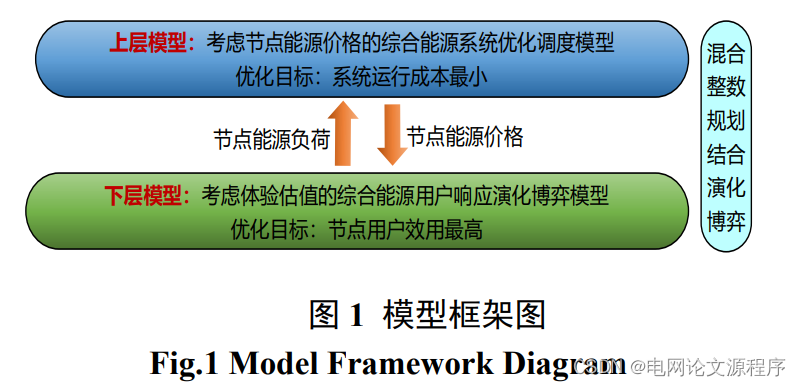文章解读与仿真程序复现思路——电网技术EI\CSCD\北大核心《考虑用户需求响应博弈推演的区域综合能源运营策略》
本专栏栏目提供文章与程序复现思路,具体已有的论文与论文源程序可翻阅本博主免费的专栏栏目《论文与完整程序》
这个标题涉及到区域综合能源运营策略,并着重考虑用户需求响应、博弈推演等因素。以下是对标题中各个关键词和短语的解读:
-
区域综合能源运营策略:
- 区域综合能源:?指涉及一个特定区域内多种能源资源的整合和管理,可能包括电力、热能、风能、太阳能等多种形式的能源。
- 运营策略:?涉及在运营过程中制定和执行的计划和方法,目的是最优化能源系统的运行。
-
用户需求响应:
- 用户需求:?表示最终用户对能源的需求,可能包括家庭、企业或其他机构。
- 响应:?意味着系统能够根据用户的需求变化作出相应的调整。
-
博弈推演:
- 博弈:?涉及参与者之间的策略性互动,每个参与者的决策会影响其他参与者。
- 推演:?意味着在未来预测和分析的过程中进行推理。
-
整体解读:
- 标题表明在能源领域的一个特定区域内,考虑了多种能源的整合和管理,制定了一种综合的运营策略。
- 该策略特别关注用户需求响应,即系统能够灵活调整以满足用户需求的变化。
- 同时,标题还指出了博弈推演的概念,说明在制定和执行这个策略的过程中,可能存在各方参与者之间的策略性互动和决策。
总体来说,这个标题表明一个综合能源系统的运营策略不仅关注能源的有效管理,还强调对用户需求的灵活响应,并在决策过程中考虑了各方的策略性互动。这种综合性的考虑可以帮助实现更高效、灵活和可持续的能源运营。
摘要:随着工商业用户能源种类多样化及其耦合程度紧密化,通过激励消费者剩余价值引导综合能源用户参与需求响应,对于降低综合能源系统运行成本以及提高用户能效,具有积极意义。该文设计了基于消费者剩余的体验估值函数,并将其考虑在用户侧目标函数中,通过演化博弈推导工商业用户参与需求响应的动态过程,从而克服传统分析方法对用户侧参与需求响应的定值设置。该文建立了基于用户侧需求响应演化博弈的综合能源系统优化运营模型,上层建立了区域综合能源系统优化模型,计算面向用户的用能价格;下层建立了考虑剩余价值的区域综合能源系统用户响应模型,并进行演化博弈推导。算例基于电-热-气综合能源系统,采用演化博弈分析了需求侧市场用户响应行为及其影响因素。结果表明,工商业两类用户参与需求响应使得综合能源系统的运行总成本降低5.5%,同时两类用户效用分别提高了51.91%和44.29%。所提模型和方法不仅可以模拟用户侧需求响应动态博弈过程,而且能够为综合能源系统中运营商和需求侧用户的策略选择提供有益参考。
这摘要介绍了一项关于综合能源系统优化运营的研究,以下是对摘要各部分的解读:
-
背景和动机:
- 工商业用户能源种类多样化及耦合程度紧密:?工商业领域内的能源类型多样,而且它们之间有紧密的联系。
- 激励消费者剩余价值引导综合能源用户参与需求响应:?通过激励消费者的剩余价值,鼓励综合能源用户积极参与需求响应。
-
方法和模型设计:
- 基于消费者剩余的体验估值函数:?设计了一个估值函数,该函数基于消费者的剩余价值,即用户感知到的附加价值。
- 演化博弈推导工商业用户参与需求响应的动态过程:?使用演化博弈方法,推导工商业用户参与需求响应的动态过程,以克服传统定值设置的限制。
- 建立了基于用户侧需求响应演化博弈的综合能源系统优化运营模型:?分上下两层建模,上层是区域综合能源系统的优化模型,计算用户用能价格;下层是考虑剩余价值的用户响应模型,进行演化博弈推导。
-
案例分析及结果:
- 算例基于电-热-气综合能源系统:?采用电-热-气综合能源系统作为案例进行分析。
- 演化博弈分析了需求侧市场用户响应行为及其影响因素:?通过演化博弈分析了用户对需求响应的行为和影响因素。
- 结果表明降低了系统运行总成本,提高了用户效用:?参与需求响应的工商业用户使得系统运行总成本降低了5.5%,同时两类用户的效用分别提高了51.91%和44.29%。
-
结论和贡献:
- 模型和方法的贡献:?所提出的模型和方法能够模拟用户侧需求响应的动态博弈过程,为综合能源系统中运营商和需求侧用户的策略选择提供有益参考。
总体而言,这项研究通过引入消费者剩余价值和演化博弈方法,提出了一种综合能源系统优化运营的新模型和方法,其结果表明在系统运行成本和用户效用方面取得了积极的成果。这对于推动综合能源系统的可持续发展具有积极的意义。
关键词:?? ?演化博弈;需求侧响应;区域综合能源市场;有限理性;
-
演化博弈:
- 演化博弈是什么:?演化博弈是一种博弈论的分支,它考虑参与者的策略在时间上的演化和变化。这种演化可能是基于个体学习、适应和变异的过程。
- 在研究中的作用:?在这个研究中,演化博弈被使用来推导工商业用户参与需求响应的动态过程。这可能涉及用户在时间内调整其响应策略,以适应市场条件或其他因素的变化。
-
需求侧响应:
- 需求侧响应是什么:?需求侧响应是指用户根据市场或系统信号调整其能源使用模式,以适应供需变化或参与市场机制。在这里,它可能涉及工商业用户根据综合能源系统的需求情况进行调整。
-
区域综合能源市场:
- 区域综合能源市场的概念:?这指的是一个地区性的市场,涉及多种能源类型,可能包括电力、热能、气体等。在研究中,建立了区域综合能源系统的优化模型,计算了面向用户的用能价格,表明研究关注了整个区域的能源市场。
-
有限理性:
- 有限理性的含义:?有限理性是指在决策过程中,个体的理性受到信息限制、认知有限和计算成本等因素的制约。这可能导致个体采用近似和简化的决策策略。
- 在研究中的角色:?在考虑有限理性的情况下,研究可能模拟了工商业用户在需求响应过程中采用的有限理性决策,从而更真实地反映了实际市场中的行为。
这些关键词表明研究关注了演化博弈在区域综合能源市场中的应用,特别是在需求侧响应方面,并考虑了参与者的有限理性。这种综合方法有助于更全面地理解和模拟综合能源市场中的动态行为和决策过程。
仿真算例:
本文算例在考虑研究方法、用户参与意愿度和 剩余价值的情况下,分四个场景对用户参与需求响 应的情况进行分析,相应场景分析表格如表 2 所示。 场景 1:不考虑用户侧参与需求响应。 场景 2:用户侧参与需求响应,不考虑消费者剩余 价值,参与意愿度设置为固定值 50%。 场景 3:用户侧参与需求响应,考虑消费者剩余价 值,演化博弈推演用户参与意愿度动态变 化过程。 场景 4:用户侧参与需求响应,考虑消费者剩余价 值,提高需求价格常数也即体验估值,通 过演化博弈对比场景 3 的用户参与意愿度 动态变化过程。
仿真程序复现思路:

复现这个仿真需要考虑以下几个步骤,并以伪代码形式表示:
import numpy as np
# 定义模型参数
evolution_game_parameters = {
'num_participants': 100,
'mutation_rate': 0.1,
}
demand_response_parameters = {
'fixed_willingness': 0.5,
}
scene_4_parameters = {
'price_constant_increase': 0.2,
}
# 初始化演化博弈参与者
def initialize_evolution_game_participants(num_participants):
participants = np.random.rand(num_participants)
return participants
# 初始化需求响应参与者
def initialize_demand_response_participants(num_participants):
willingness = np.full(num_participants, demand_response_parameters['fixed_willingness'])
residual_value = np.random.rand(num_participants)
return willingness, residual_value
# 模拟演化博弈
def evolve(participants, mutation_rate):
mutations = np.random.uniform(low=-mutation_rate, high=mutation_rate, size=len(participants))
participants += mutations
participants = np.clip(participants, 0, 1)
return participants
# 模拟需求响应
def update_demand_response(willingness, residual_value):
willingness += np.random.normal(0, 0.1, len(willingness))
willingness = np.clip(willingness, 0, 1)
residual_value = np.random.rand(len(residual_value))
return willingness, residual_value
# 场景分析
def simulate_scene_1():
evolution_game_participants = initialize_evolution_game_participants(evolution_game_parameters['num_participants'])
for iteration in range(num_iterations):
evolution_game_participants = evolve(evolution_game_participants, evolution_game_parameters['mutation_rate'])
return evolution_game_participants
def simulate_scene_2():
demand_response_participants = initialize_demand_response_participants(demand_response_parameters['num_participants'])
for iteration in range(num_iterations):
demand_response_participants = update_demand_response(*demand_response_participants)
return demand_response_participants[0] # Returning only willingness for simplicity
def simulate_scene_3():
# Similar to simulate_scene_2, but considering residual value in the update_demand_response function
pass
def simulate_scene_4():
demand_response_participants = initialize_demand_response_participants(demand_response_parameters['num_participants'])
for iteration in range(num_iterations):
demand_response_participants = update_demand_response(*demand_response_participants)
# Increase demand price constant
demand_response_participants[0] += scene_4_parameters['price_constant_increase']
return demand_response_participants[0] # Returning only willingness for simplicity
# 主程序
num_iterations = 100
results_scene_1 = simulate_scene_1()
results_scene_2 = simulate_scene_2()
results_scene_3 = simulate_scene_3()
results_scene_4 = simulate_scene_4()
这个伪代码更详细地演示了模型参数的定义、参与者的初始化、演化博弈和需求响应的模拟过程,以及不同场景的仿真过程。请注意,这只是一个简化的例子,实际应用可能需要更复杂的模型和算法。
本文来自互联网用户投稿,该文观点仅代表作者本人,不代表本站立场。本站仅提供信息存储空间服务,不拥有所有权,不承担相关法律责任。 如若内容造成侵权/违法违规/事实不符,请联系我的编程经验分享网邮箱:chenni525@qq.com进行投诉反馈,一经查实,立即删除!
- Python教程
- 深入理解 MySQL 中的 HAVING 关键字和聚合函数
- Qt之QChar编码(1)
- MyBatis入门基础篇
- 用Python脚本实现FFmpeg批量转换
- 网络通信--深入理解网络和TCP / IP协议
- LVGL,tabview用实体按键切换tab的事件回调实现
- Mysql数据库
- [Java][异常]自定义异常的设计逻辑与应用
- 数据结构——二叉树四种遍历的实现
- [Linux 进程(五)] 程序地址空间深度剖析
- 基于 MQTT 的开源桥接器:自由控制物联网设备 | 开源日报 No.151
- 字符串相关笔记
- Apache Flink连载(二十):Flink On Yarn运行 - Yarn Per-Job模式(弃用)
- 如何群发邮件outlook?外贸邮件群发教程?